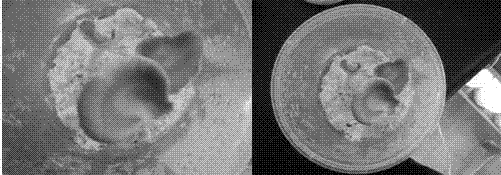Method for cultivating oyster mushroom by using broken rice
A technology for oyster mushrooms and broken rice, which is applied in the directions of botanical equipment and methods, applications, organic fertilizers, etc., can solve the problems of waste of resources, affecting the economic benefits of polished rice processing, etc., and achieves pollution-free, easy cultivation and production, and rapid growth of bacteria. quick effect
- Summary
- Abstract
- Description
- Claims
- Application Information
AI Technical Summary
Problems solved by technology
Method used
Image
Examples
Embodiment 1
[0021] The solid-to-liquid ratio of broken rice and nutrient solution is 1:1.2, and the formula of described nutrient solution is as follows: Potassium dihydrogen phosphate 1g / L, magnesium sulfate 0.5g / L, sucrose 18g / L, ammonium citrate 0.5g / L, Peptone 1.5g / L.
[0022] Its specific implementation steps are as follows:
[0023] (1) Preparation of medium: Weigh the above-mentioned potassium dihydrogen phosphate, magnesium sulfate, sucrose, ammonium citrate, and peptone and dissolve them in water to make a nutrient solution. Weigh broken rice in proportion and configure it as a medium for oyster mushrooms. Put the culture material into the cultivation box, put 50g in each box, sterilize the cultivation box in an autoclave at 121°C for 20min, and take it out for use;
[0024] (2) Inoculation: When the temperature of the medium drops to 36°C, inoculate Pleurotus ostreatus bacteria into the medium, and the inoculum volume is 6%vol;
Embodiment 2
[0028] The solid-to-liquid ratio of broken rice and nutrient solution is 1:1.3, and the formula of described nutrient solution is as follows: Potassium dihydrogen phosphate 1.8g / L, magnesium sulfate 0.8g / L, sucrose 20g / L, ammonium citrate 0.8g / L , Peptone 1.8g / L.
[0029] Its specific implementation steps are as follows:
[0030] (1) Preparation of medium: Weigh the above-mentioned potassium dihydrogen phosphate, magnesium sulfate, sucrose, ammonium citrate, and peptone and dissolve them in water to make a nutrient solution. Weigh broken rice in proportion and configure it as a medium for oyster mushrooms. Put the culture material into the cultivation box, put 50g in each box, sterilize the cultivation box in an autoclave at 121°C for 20min, and take it out for use;
[0031] (2) Inoculation: When the temperature of the medium drops to 38°C, inoculate Pleurotus ostreatus bacteria into the medium, and the inoculum volume is 7%vol;
[0032] (3) Bacteria: Cultivate in a dark roo...
Embodiment 3
[0035] The solid-to-liquid ratio of broken rice and nutrient solution is 1:1.4, and the formula of described nutrient solution is as follows: Potassium dihydrogen phosphate 2g / L, magnesium sulfate 1.0g / L, sucrose 22g / L, ammonium citrate 1.0g / L, Peptone 2g / L.
[0036] Its specific implementation steps are as follows:
[0037] (1) Preparation of medium: Weigh the above-mentioned potassium dihydrogen phosphate, magnesium sulfate, sucrose, ammonium citrate, and peptone and dissolve them in water to make a nutrient solution. Weigh broken rice in proportion and configure it as a medium for oyster mushrooms. Put the culture material into the cultivation box, put 50g in each box, sterilize the cultivation box in an autoclave at 121°C for 20min, and take it out for use;
[0038] (2) Inoculation: When the temperature of the medium drops to 40°C, inoculate Pleurotus ostreatus bacteria into the medium, and the inoculum volume is 8%vol;
PUM
 Login to View More
Login to View More Abstract
Description
Claims
Application Information
 Login to View More
Login to View More - R&D
- Intellectual Property
- Life Sciences
- Materials
- Tech Scout
- Unparalleled Data Quality
- Higher Quality Content
- 60% Fewer Hallucinations
Browse by: Latest US Patents, China's latest patents, Technical Efficacy Thesaurus, Application Domain, Technology Topic, Popular Technical Reports.
© 2025 PatSnap. All rights reserved.Legal|Privacy policy|Modern Slavery Act Transparency Statement|Sitemap|About US| Contact US: help@patsnap.com

